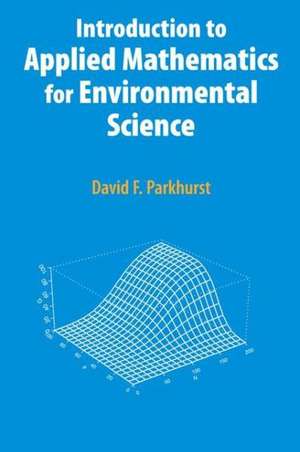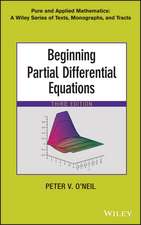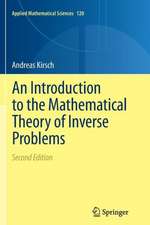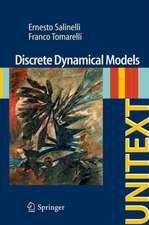Introduction to Applied Mathematics for Environmental Science
Autor David F. Parkhursten Limba Engleză Paperback – 18 oct 2010
| Toate formatele și edițiile | Preț | Express |
|---|---|---|
| Paperback (1) | 489.48 lei 6-8 săpt. | |
| Springer Us – 18 oct 2010 | 489.48 lei 6-8 săpt. | |
| Hardback (1) | 648.24 lei 6-8 săpt. | |
| Springer Us – 28 iun 2006 | 648.24 lei 6-8 săpt. |
Preț: 489.48 lei
Nou
Puncte Express: 734
Preț estimativ în valută:
93.67€ • 97.44$ • 77.33£
93.67€ • 97.44$ • 77.33£
Carte tipărită la comandă
Livrare economică 15-29 aprilie
Preluare comenzi: 021 569.72.76
Specificații
ISBN-13: 9781441941695
ISBN-10: 144194169X
Pagini: 328
Ilustrații: IX, 317 p.
Dimensiuni: 155 x 235 x 17 mm
Greutate: 0.46 kg
Ediția:Softcover reprint of hardcover 1st ed. 2006
Editura: Springer Us
Colecția Springer
Locul publicării:New York, NY, United States
ISBN-10: 144194169X
Pagini: 328
Ilustrații: IX, 317 p.
Dimensiuni: 155 x 235 x 17 mm
Greutate: 0.46 kg
Ediția:Softcover reprint of hardcover 1st ed. 2006
Editura: Springer Us
Colecția Springer
Locul publicării:New York, NY, United States
Public țintă
GraduateCuprins
Derivatives and Differentiation.- Integration.- Ordinary Differential Equations.- Further Topics in ODEs.- Systems of Ordinary Differential Equations.- Numerical Solution of Ordinary Differential Equations.- Second-Order ODEs.- Linear Algebra.- Non-Linear Equations.- Partial Differential Equations.
Recenzii
From the reviews:
"It … explains how basic tools of mathematical analysis can be efficiently used to study problems arising in environmental sciences. … The text shall attract non-mathematical audience by clarity of exposition which concentrates mostly on ideas and techniques … . Specifically tailored to the needs of undergraduate and graduate students in environmental sciences, this unique and skillfully written book shall help them to understand and master fundamental mathematical concepts and techniques used in the analysis of applied problems." (Yuri V. Rogovchenko, Zentralblatt MATH, Vol. 1145, 2008)
"It … explains how basic tools of mathematical analysis can be efficiently used to study problems arising in environmental sciences. … The text shall attract non-mathematical audience by clarity of exposition which concentrates mostly on ideas and techniques … . Specifically tailored to the needs of undergraduate and graduate students in environmental sciences, this unique and skillfully written book shall help them to understand and master fundamental mathematical concepts and techniques used in the analysis of applied problems." (Yuri V. Rogovchenko, Zentralblatt MATH, Vol. 1145, 2008)
Textul de pe ultima copertă
Introduction to Mathematics for Environmental Science evolved from the author’s 30 years’ experience teaching mathematics to graduate and advanced undergraduate students in the environmental sciences. Its basic purpose is to teach various types of mathematical structures and how they can be applied in a broad range of environmental science subfields. Derivatives and integrals, ordinary and partial differential equations, and linear and non-linear algebraic equations are the basic kinds of structures (types of mathematical models) discussed.
For each mathematical topic, the book emphasizes derivation of mathematical models from "story problems" first, and solution of equations second. It suggests finding analytic solutions when possible, but discusses methods for finding numerical solutions to problems that can’t be solved analytically. For most topics, examples of using Matlab software to solve and explore the structures are also included.
This text assumes that its readers will already have been introduced to the basic ideas of differential and integral calculus, so it is not an introduction to calculus. It does, however, include three early chapters to review basic algebra, derivatives, and integrals.
Professor Parkhurst earned his B.S. degree in applied mathematics from the College of Engineering, University of Colorado, Boulder, in 1965, and his Ph.D. in Botany (Plant Ecology) from the University of Wisconsin, Madison, in 1970. He then worked three years at the CSIRO Division of Atmospheric Science in Aspendale, Victoria, Australia, before joining the Environmental Science faculty of the School of Public and Environmental Affairs, Indiana University, Bloomington, in 1973. He held a joint appointment in the Biology Department there as well. He retired from that position in December, 2005, after 32 years. His research areas include mathematical modelling of adaptations of plant leaves to environment, environmental riskanalysis, and applications of statistics in environmental and public health areas.
For each mathematical topic, the book emphasizes derivation of mathematical models from "story problems" first, and solution of equations second. It suggests finding analytic solutions when possible, but discusses methods for finding numerical solutions to problems that can’t be solved analytically. For most topics, examples of using Matlab software to solve and explore the structures are also included.
This text assumes that its readers will already have been introduced to the basic ideas of differential and integral calculus, so it is not an introduction to calculus. It does, however, include three early chapters to review basic algebra, derivatives, and integrals.
Professor Parkhurst earned his B.S. degree in applied mathematics from the College of Engineering, University of Colorado, Boulder, in 1965, and his Ph.D. in Botany (Plant Ecology) from the University of Wisconsin, Madison, in 1970. He then worked three years at the CSIRO Division of Atmospheric Science in Aspendale, Victoria, Australia, before joining the Environmental Science faculty of the School of Public and Environmental Affairs, Indiana University, Bloomington, in 1973. He held a joint appointment in the Biology Department there as well. He retired from that position in December, 2005, after 32 years. His research areas include mathematical modelling of adaptations of plant leaves to environment, environmental riskanalysis, and applications of statistics in environmental and public health areas.
Caracteristici
Is only one that shows how to apply calculus to environmental problems Teaches calculus to graduate students as an everyday tool for ecology and other environmental sciences Includes supplementary material: sn.pub/extras










